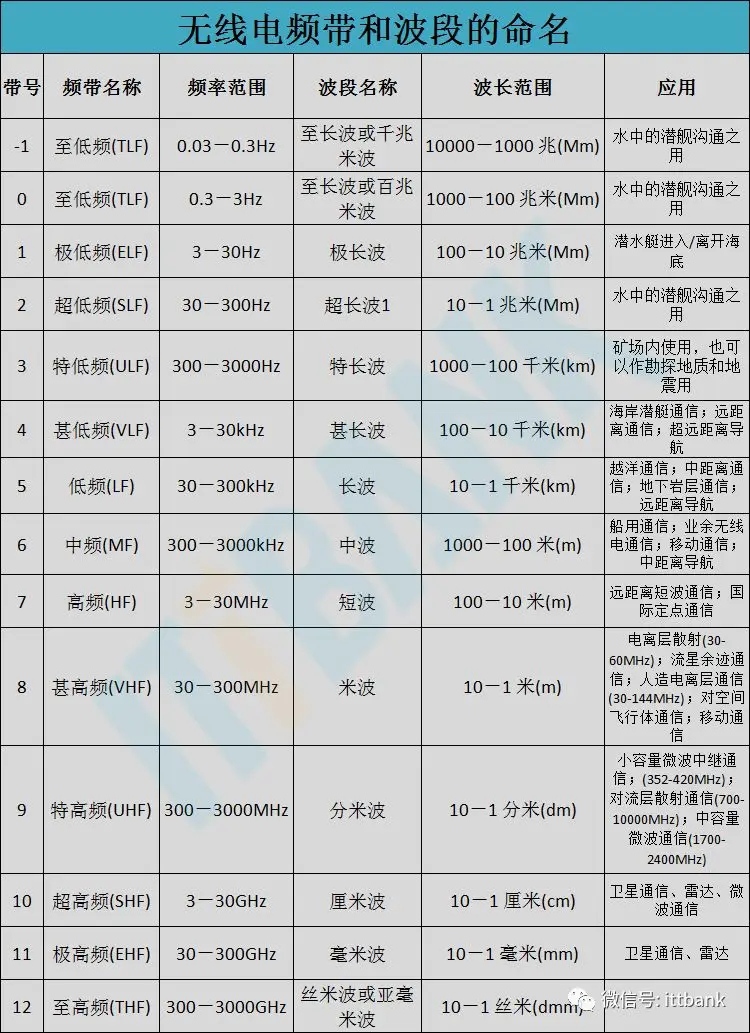



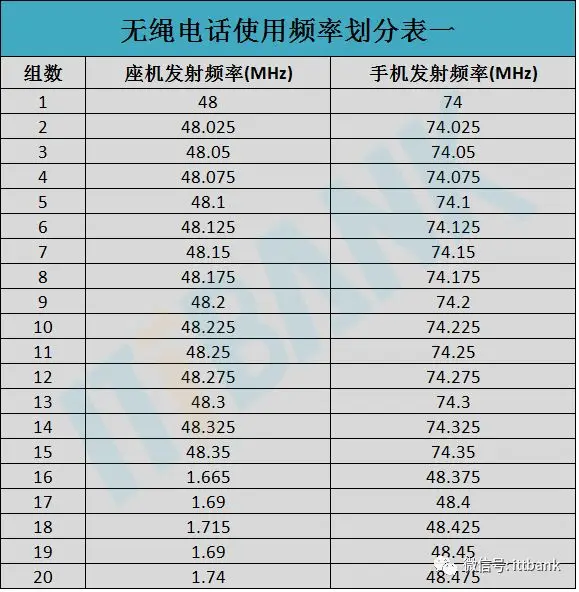
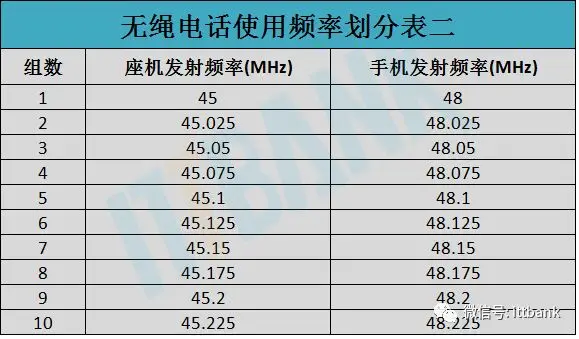
Note: Table 1 was formulated by the Ministry of Industry and Information Technology of China in 1985, and Table 2 was formulated in 1992. It stipulates that the channel spacing for cordless phones is 25KHz, with a maximum transmission power of 50mW for landline phones and 20mW for mobile phones. The transmission categories are F3E; F1D; G3E.
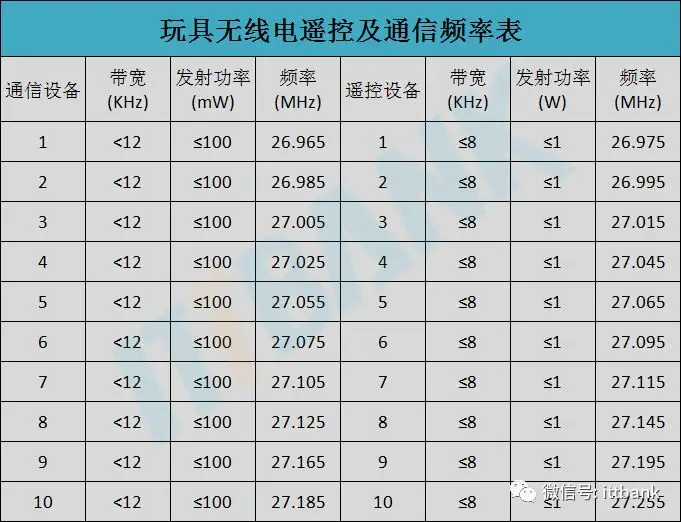
Note: 315MHz: Many car manufacturers use the “315MHz” car remote key.
Introduction to 40 Wireless Communication Transmission Technologies and Their Frequency Allocations:
1. 5G
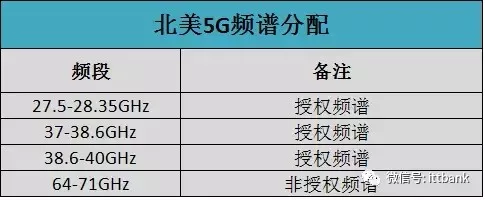

2. LTE/LTE-Advanced/LTE-Advanced Pro (4G)
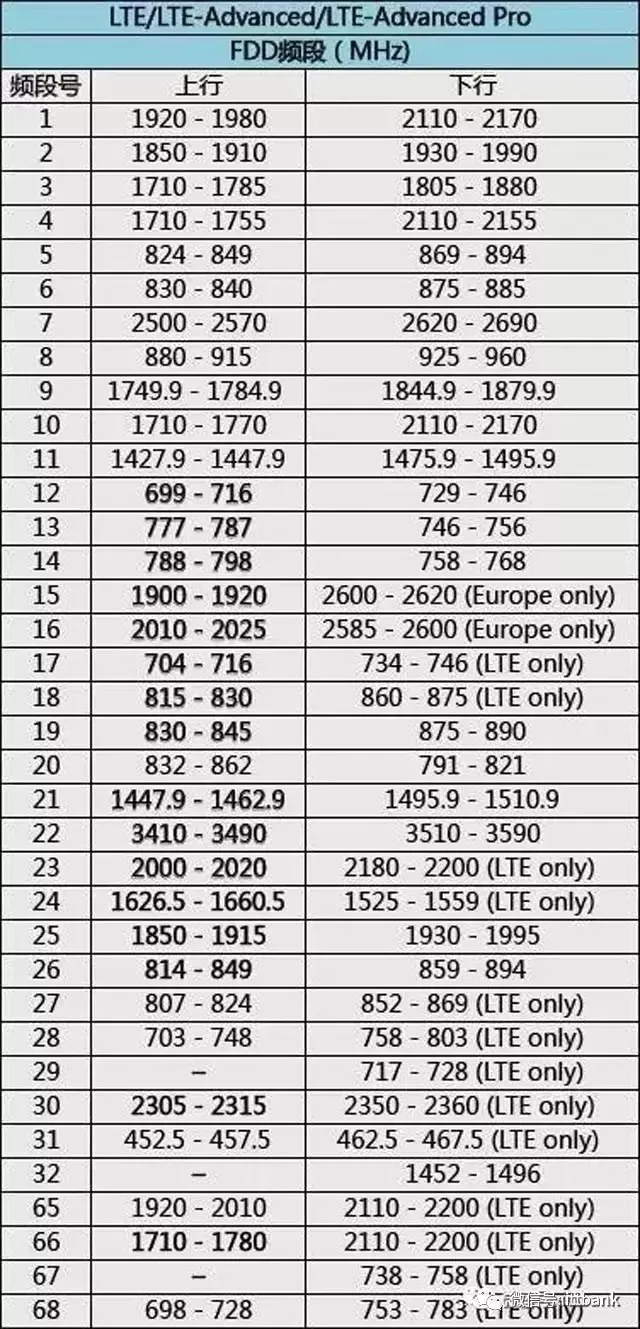

3. WCDMA/HSPA/HSPA+ (3G)
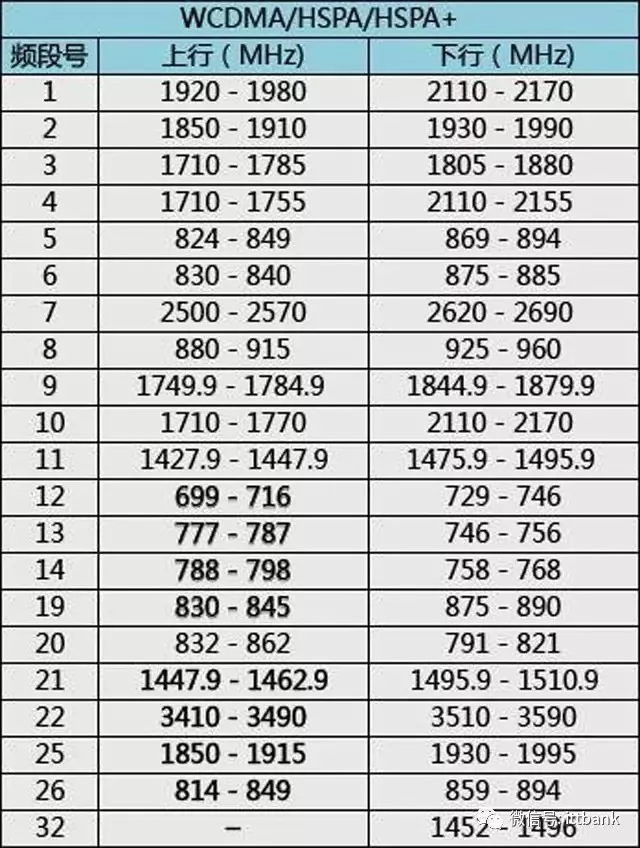
4. TD-SCDMA (3G)
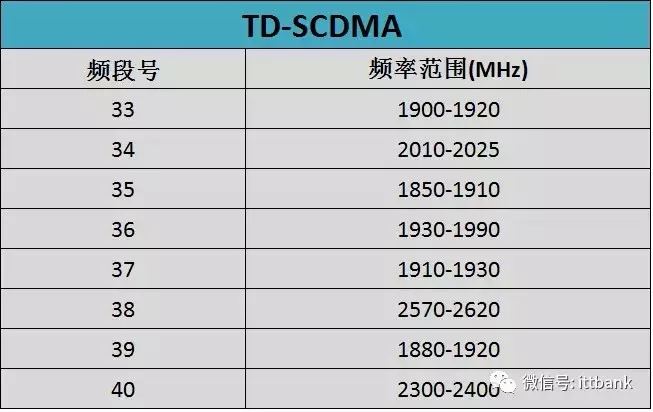
5. GSM/GPRS/EDGE/EDGE Evolution/VAMOS (2G)

Remarks:
P-GSM, benchmark GSM-900 band
E-GSM, extended GSM-900 band (including benchmark GSM-900 band)
R-GSM, railway GSM-900 band (including benchmark and extended GSM-900 band)
T-GSM, trunked wireless system-GSM
ER-GSM900, which is the Extended Railway GSM 900, expands its frequency range based on the original railway communication system (TX: 873-915, RX: 918-960).
6. CDMA2000 1xEV-DO/CDMA2000 1xRTT/1xAdvanced (3G)
Frequency division of the three major operators:
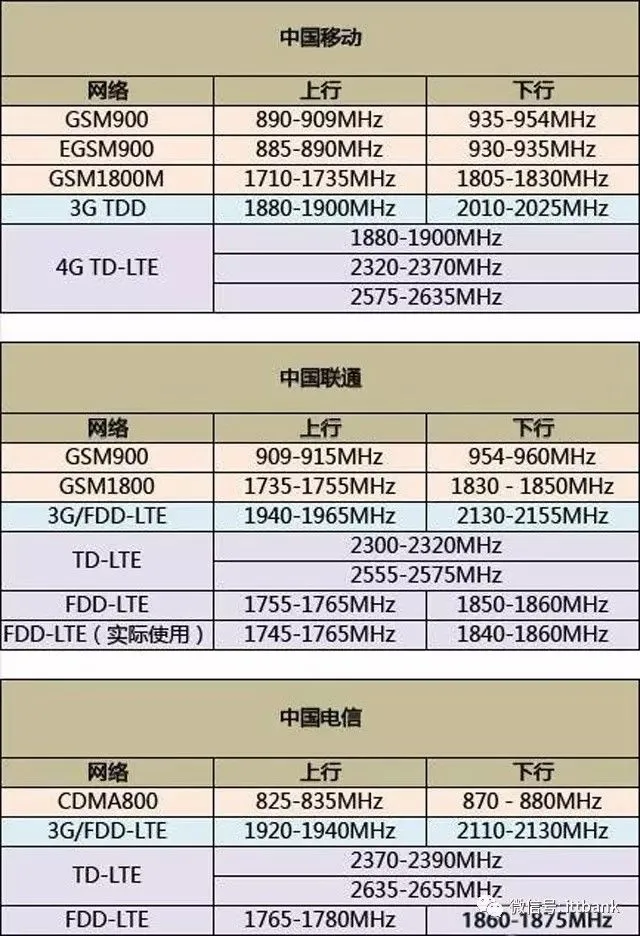
7. WiFi
Wi-Fi is a technology that allows electronic devices to connect to a wireless local area network (WLAN), typically using the 2.4G UHF or 5G SHF ISM radio frequency bands. Connecting to a WLAN is usually password-protected; however, it can also be open, allowing any device within the WLAN range to connect. Wi-Fi is a brand of wireless network communication technology owned by the Wi-Fi Alliance, aimed at improving interoperability between wireless network products based on the IEEE 802.11 standards. Some refer to local area networks using the IEEE 802.11 series protocols as wireless fidelity. Wi-Fi is even equated with wireless internet access (Wi-Fi is an important component of WLAN).
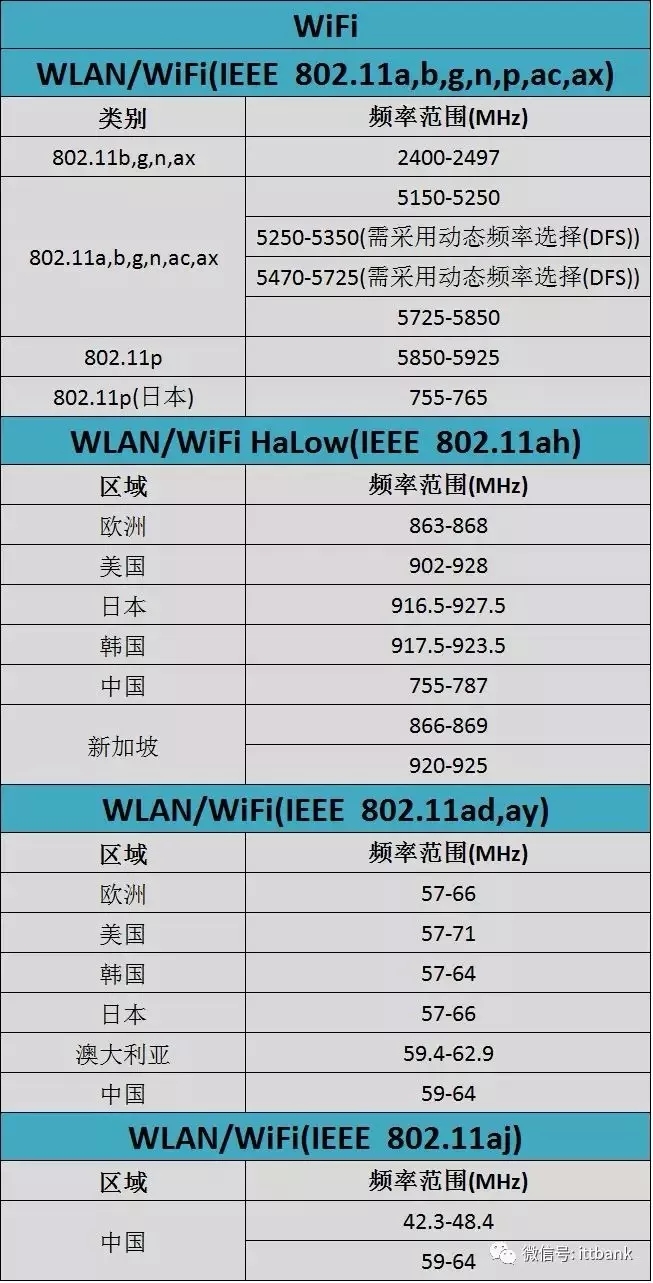
8. Bluetooth
Bluetooth enables point-to-point or point-to-multipoint wireless data and audio transmission within a radius of 10 meters, with a data transfer bandwidth of up to 1Mbps, using electromagnetic waves in the frequency range of 2.402GHz to 2.480GHz. Bluetooth technology can be widely applied in various data and voice devices in local area networks, such as PCs, dial-up networks, laptops, printers, fax machines, digital cameras, mobile phones, and high-quality headsets, enabling communication between various devices anytime and anywhere.
Bluetooth technology is widely used in wireless office environments, automotive industry, information appliances, medical devices, as well as in school education and factory automation control. The main problems currently faced by Bluetooth are the size and cost of chips; and its anti-interference capability is relatively weak.

9. ZigBee/Thread/6LoWPAN
ZigBee is a short-range, low-power wireless communication technology established based on the IEEE802.15.4 standard. ZigBee derives its name from the communication method of a swarm of bees, as bees communicate with each other to determine the direction, location, and distance of food sources through flying and buzzing (Zig). Its characteristics include short distance, typically transmitting at 10-100m; low power consumption, where two AA batteries can support one terminal for 6-24 months or even longer in low power standby mode; low cost, ZigBee has no protocol fees and cheap chips; low speed, typically operating at 20-250kbps; and short delay, with a fast response time. It is mainly suitable for home and building control, industrial automation control, agricultural information collection and control, public information detection and control, smart tags, etc., and can be embedded in various devices.
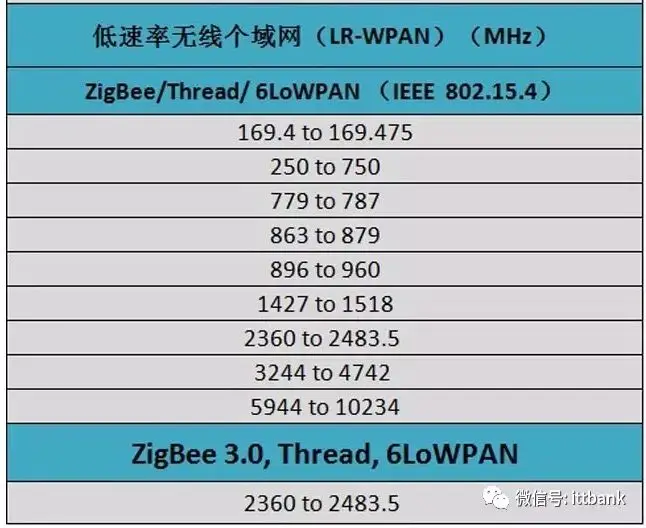
10. NFC
NFC is a new near-field wireless communication technology that operates at a frequency of 13.56MHz, developed from 13.56MHz radio frequency identification (RFID) technology. It operates at the same frequency as the widely popular contactless smart card ISO14443, providing a convenient communication method for all consumer electronics. NFC uses amplitude shift keying (ASK) modulation, with data transfer rates typically at 106kbit/s and 424kbit/s. The main advantages of NFC are: short distance, high bandwidth, low energy consumption, and compatibility with contactless smart card technology, with broad application value in access control, public transport, and mobile payments.

11. RFID
RFID (Radio Frequency Identification) technology, also known as wireless radio frequency identification, is a communication technology commonly referred to as electronic tagging. It can identify specific targets and read/write relevant data through radio signals without the need for mechanical or optical contact between the identification system and the specific target.
12. IrDA Infrared Communication
Infrared communication mainly consists of three parts:
Transmitter part: Currently, the information sources for infrared wireless digital communication systems include voice, data, images, etc.
Channel part: Their roles include shaping, filtering, field transformation, and frequency band division.
Terminal part: The terminal part of the infrared wireless digital communication system includes the optical receiving part, sampling, filtering, judgment, quantization, equalization, and decoding.

13. Ultra-Wideband (UWB)
UWB is a carrier-free communication technology that uses nanosecond to microsecond non-sinusoidal narrow pulses to transmit data, with a typical transmission distance of less than 10M, using bandwidth above 1GHz, and communication speeds reaching several hundred megabits per second. The UWB operating frequency range is from 3.1GHz to 10.6GHz, with a minimum operating bandwidth of 500MHz.
Its main characteristics include: high transmission rate; low emission power and small power consumption; strong confidentiality; UWB communication uses timing sequences, which can resist multipath fading; and UWB requires very few RF and microwave components, which can reduce system complexity. Due to the high bandwidth occupied by UWB systems, they may interfere with existing wireless communication systems. UWB is mainly applied in high-resolution “short-range” radar and imaging systems that can penetrate walls and other obstacles.
This device can be used to check for defects in concrete and asphalt structures in buildings, bridges, and roads, as well as to locate faults in underground cables and other pipelines, and can also be used for disease diagnosis. Additionally, it has significant applications in rescue, public security prevention, firefighting, and medical imaging processing.
Ultra-Wideband (UWB) radio devices have an equivalent isotropic radiated power spectral density limit for UWB transmission signals:

Note 1: For the frequency band 4.2-4.8GHz, before December 31, 2010, the equivalent isotropic radiated power spectral density limit for UWB radio transmission devices can be -41dBm/MHz. After this date, UWB devices in this frequency band must adopt signal detection avoidance and other interference mitigation technologies, the effectiveness of which must be recognized by the national radio management authority.

14. NB-IoT
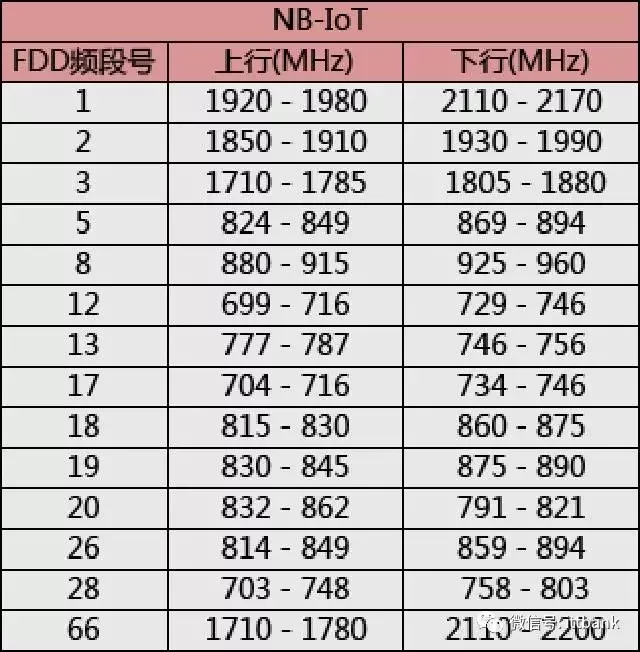
15. SIGFOX
SigFox, founded in 2009, is a French company headquartered in Labège. SigFox has been very successful in Europe and can be said to be the most attractive (or at least the most well-known) in the LPWAN field. It also has a great vendor ecosystem, including Texas Instruments, Silicon Labs, and Axom.
SigFox uses proprietary technology and lower modulation rates to achieve longer transmission ranges. Based on this design, SigFox is a great choice for application scenarios that only require sending small, infrequent bursts of data.
Typical applications of SigFox include parking sensors, water meters, or smart trash bins. Of course, it also has some drawbacks. The ability to send data back to sensors and devices (downlink capability) is severely limited, and signal interference can become a problem.

16. LoRaWAN
The LoRa Alliance is an open non-profit organization aimed at promoting and advancing the ecosystem of LPWAN technology. It has about 400 member companies in North America, Europe, Africa, and Asia, with founding members including IBM, MicroChip, Cisco, Semtech, Bouygues Telecom, Singtel, KPN, Swisscom, Fastnet, and Belgacom.
LoRaWAN is an open standard network layer protocol managed by the LoRa Alliance. However, it is not truly open, because the underlying chips needed to implement a complete LoRaWAN protocol stack can only be provided by Semtech. Specifically, LoRa is the physical layer, which is the chip. LoRaWAN is the MAC layer, which is the software on the chip used to achieve network connectivity.
Its function is similar to SigFox, as it is mainly used for applications targeting only uplink data from sensors and devices to gateways. It does not use narrowband transmission but uses encoded messages to extend information across different frequency channels and data rates. These messages reduce collisions and interference, thereby increasing the capacity of the gateways.

17. Weightless-N/NWave
Nwave is very similar to SigFox in functionality, but it claims to have a better MAC layer implementation. It claims to use advanced demodulation technology to support the coexistence of its network with other radio technologies without causing additional communication interference. Like SigFox, it excels in sensor-based network communications, temperature collection, water level monitoring, smart measurement, and other similar applications.
18. Weightless-P
This standard uses FDMA + TDMA modulation in a 12.5 kHz narrowband (greater than SigFox but less than LoRa). It also features adaptive data rates, similar to Symphony Link (200bps to 100kbps). It has high sensitivity, with a signal strength of -134 dBm at a transmission rate of 625 bps, while supporting PSK and GMSK modulation.
Weightless-P is suitable for private network application scenarios that have important requirements for both uplink and downlink data and relatively complex business needs. Development kits for Weightless-P have already been released.
19. RPMA
Random Phase Multiple Access (RPMA) is a proprietary LPWAN technology stack developed by Ingenu. The company was founded in 2008 in San Diego, California, by former Qualcomm engineers, initially named On-Ramp Wireless.
As a founding member of the IEEE 802.15.4k task group (dedicated to low-power device monitoring), Ingenu has made significant efforts in developing RPMA, while the SigFox and LoRaWAN groups have focused on accelerating time to market.
RPMA’s technical architecture makes it superior in both uplink and downlink bidirectional communication compared to other technologies. It claims to have better Doppler effects, scheduling algorithms, and anti-interference capabilities. It operates in the globally available 2.4 GHz band (used for WiFi and Bluetooth). This means it does not require changes and adjustments to its technical architecture for different regions, as SigFox and LoRa do.
According to its internal research, RPMA has higher communication distance metrics: RPMA is 177, while SigFox and LoRa are 149 and 157, respectively. This means RPMA has a larger coverage area.
20. Symphony Link
Link Labs is a member of the LoRa Alliance, so it uses LoRa chips. However, Link Labs does not use LoRaWAN but builds a proprietary MAC layer called Symphony Link on top of Semtech’s chips.
Link Labs was founded in 2013 by former members of the Johns Hopkins University Applied Physics Laboratory and is headquartered in Annapolis, Maryland.
Compared to LoRaWAN, Symphony Link adds some important connectivity features, including: guaranteed message reliability, firmware over-the-air upgrades, removal of duty cycle restrictions, providing relay functionality, and dynamic scalability.
21. Weightless
Weightless SIG (Special Interest Group) was established in 2008, with the mission of standardizing LPWAN. There are five founding members, including Accenture, ARM, M2COMM, Sony Europe, and Telensa.
Weightless is the only truly open standard below 1GHz in the unlicensed spectrum. Weightless has three versions targeting different application scenarios:
Weightless-W: Not yet used (unused local spectrum in the authorized TV band)
Weightless-N: Unlicensed spectrum narrowband protocol born from NWave technology
Weightless-P: Bidirectional protocol born from M2COMM’s Platanus technology
Although Weightless-W has lower power consumption, Weightless-N and Weightless-P are still more popular.
22. WiMAX (Worldwide Interoperability for Microwave Access)
WiMAX, also known as 802.16 Wireless Metropolitan Area Network or 802.16, is an emerging broadband wireless access technology that can provide high-speed internet connectivity, with a maximum data transmission distance of up to 50km. WiMAX also has advantages such as QoS assurance, high transmission rates, and diverse services. WiMAX has a high technical starting point, employing advanced technologies such as OFDM/OFDMA, AAS, and MIMO, which represent the future direction of communication technology development.
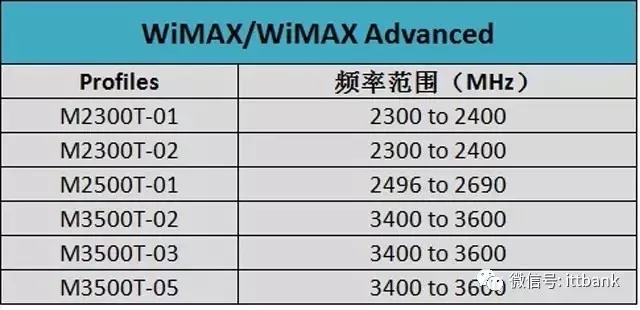
23. TETRA/TETRA 2
TETRA supports user terminal services including: individual calls (point-to-point), group calls (point-to-multipoint), response group calls, broadcast calls (one-way point-to-multipoint), and various forms of clear or encrypted communication.
TETRA supports bearer services including: packet data, circuit data.
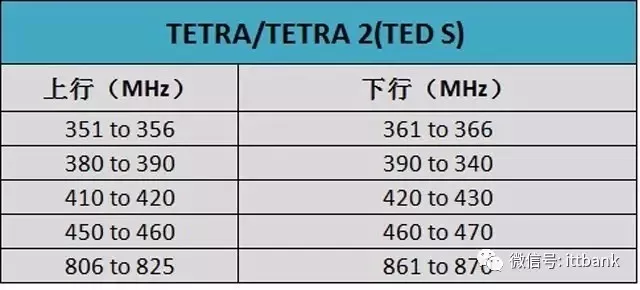
24. Tetrapol

25. Project 25/APCO-25
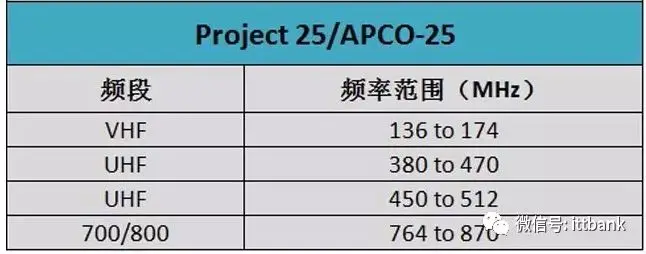
26. Digital Enhanced Cordless Telecommunications (DECT)

27. Global Navigation Satellite System (GNSS)
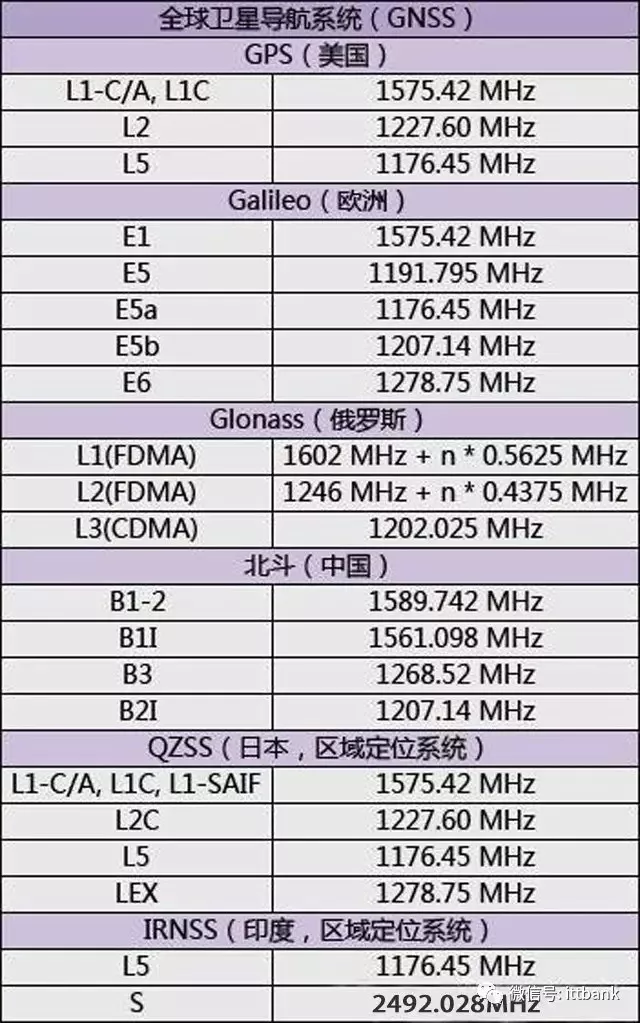
28. Digital Wireless Data Transmission Radio
The digital wireless data transmission radio is a type of radio that employs digital signal processing, digital modulation and demodulation, and features such as forward error correction and equalization. The working frequency of the digital transmission radio mostly uses the 220-240MHz or 400-470MHz bands, offering advantages such as compatibility with both voice and data, good real-time data transmission, dedicated data transmission channels, one-time investment, no operational costs, suitability for harsh environments, and good stability. The effective coverage radius of digital transmission radios is several tens of kilometers, capable of covering a city or a certain area. Digital transmission radios typically provide standard RS-232 data interfaces for direct connection with computers, data collectors, RTUs, PLCs, data terminals, GPS receivers, digital cameras, etc. They have been widely applied across various industries, including aerospace, railways, electricity, petroleum, meteorology, and seismology, and have made significant advancements in remote control, telemetry, signaling, remote sensing, and SCADA fields.
29. Spread Spectrum Microwave Communication
Spread spectrum communication refers to a communication technology where the bandwidth of the signal used to transmit information is much larger than the bandwidth of the information itself. Initially used for military communications, its basic principle is to modulate the information being transmitted with a pseudo-random code sequence (spread spectrum code), where the rate of the pseudo-random code is much greater than the information transmission rate, achieving frequency spectrum expansion while significantly reducing the radiated power spectral density of the transmitted signal. At the receiving end, the same spread spectrum code is used for correlation demodulation and information recovery! Its main characteristics include: strong anti-noise capability; strong anti-interference capability; strong anti-fading capability; strong anti-multipath interference capability; easy multimedia communication networking; good secure communication capabilities; and it does not interfere with other similar systems, while also having long transmission distances and wide coverage, making it particularly suitable for outdoor networking applications.
30. Wireless Bridge
A wireless bridge is a product that combines wireless RF technology and traditional wired bridge technology. It is designed for point-to-point interconnection using wireless (microwave) for long-distance data transmission. It is a storage and forwarding device that realizes LAN interconnection at the link layer, capable of long-distance (up to 50Km), high-speed (up to 100Mbps) wireless networking between fixed digital devices. Both spread spectrum microwave and wireless bridge technologies can be used to transmit high-bandwidth video surveillance and other large data signal transmission services.
31. Satellite Communication
Satellite communication refers to the use of artificial earth satellites as relay stations to forward radio signals, enabling communication between multiple ground stations. It is the inheritance and development of ground microwave communication. A satellite communication system typically consists of two parts: the satellite end, which is airborne, mainly used to amplify and forward signals sent from ground stations to other ground stations, and the ground end, which is mainly used for controlling and tracking satellites as well as enabling ground communication systems to access satellite communication systems.
Satellites can be categorized into synchronous and non-synchronous satellites. Synchronous satellites have the same orbital direction and period as the Earth’s rotation, appearing stationary from any position on the ground; non-synchronous satellites have orbital periods greater than or less than the Earth’s rotation period, with their orbital height, inclination, and shape adjustable as needed.
The characteristics of satellite communication include: wide coverage, broad operating frequency band, good communication quality, and independence from geographical conditions, with costs unrelated to communication distances. Its main applications are in international communication, domestic communication, military communication, mobile communication, and broadcasting.
Satellite communication’s main drawback is that it has a certain delay in communication; for example, when making a satellite phone call, one cannot immediately hear the other party’s response, mainly due to the long transmission distance of satellite communication, where radio waves experience a certain delay in the air.
32. Shortwave Communication
According to the International Radio Consultative Committee’s classification, shortwave refers to electromagnetic waves with wavelengths between 100m and 10m and frequencies between 3MHz and 30MHz. Shortwave communication refers to radio communication conducted using shortwave, also known as high-frequency (HF) communication. Shortwave communication can be divided into ground wave propagation and sky wave propagation. Ground wave propagation experiences increased attenuation with rising operating frequencies, where higher frequencies result in greater attenuation under the same ground conditions. Ground waves only apply to short-distance communication, typically operating at frequencies below 5MHz.
Ground wave propagation is less affected by weather and is relatively stable, with channel parameters not varying significantly over time, allowing the channel to be viewed as a constant parameter channel. Sky wave propagation involves radio waves being reflected by the ionosphere for long-distance communication; inclined electromagnetic waves can be reflected by the ionosphere to reach ground locations thousands of kilometers away.
Sky wave propagation experiences much lower losses than ground waves, and after multiple reflections between the ground and ionosphere, can reach extremely far distances, enabling global communication. However, sky wave propagation is extremely unstable due to severe influences from ionospheric changes and multipath propagation, leading to rapid variations in channel parameters, thus referred to as variable parameter channels. The characteristics of shortwave communication include: low construction and maintenance costs, short cycles, simple equipment, easy circuit scheduling, strong anti-damage capabilities, narrow frequency bands, and small communication capacity, with poor signal stability in sky wave channels.
33. COFDM
COFDM (Coded Orthogonal Frequency Division Multiplexing) is a technology that converts high-speed data streams through serial-parallel conversion, distributing them to several sub-channels with lower transmission rates for transmission. COFDM is based on the idea of expanding information in both frequency and time domains, using coding to make the signal received by each unit code during transmission statistically independent, thus eliminating the effects of flat fading and Doppler frequency shifts, providing strong diffraction and anti-interference capabilities. This technology is used in drone video transmission.

34. EnOcean
The EnOcean wireless communication standard has been adopted as the international standard “ISO/IEC 14543-3-10”, which is the only international standard using energy harvesting technology in the world. The EnOcean energy harvesting module can collect energy generated by the surrounding environment from light, heat, radio waves, vibrations, human motion, etc., to obtain weak power. This energy is processed to supply the EnOcean ultra-low-power wireless communication module, achieving a truly wireless communication system without data lines, power lines, or batteries. The EnOcean wireless standard ISO/IEC14543-3-10 operates in the 868MHz, 902MHz, 928MHz, and 315MHz bands, with transmission distances of 300 meters outdoors and 30 meters indoors.
35. Z-Wave
Z-Wave is a wireless networking specification led by the Danish company Zensys. Z-Wave is an emerging, low-cost, low-power, highly reliable, short-range wireless communication technology based on RF. The operating frequency bands are 908.42MHz and 868.42MHz, with effective coverage ranges of 30m indoors and over 100m outdoors, suitable for narrow bandwidth applications. Z-Wave technology is also low-power and low-cost, significantly promoting low-rate wireless personal area networks.
36. WHDI
WHDI stands for Wireless Home Digital Interface, which, as the name suggests, is mainly applied indoors, based on the global 5GHz spectrum regulations, operating in the 4.9GHz to 5.875GHz bands, occupying bandwidths of approximately 20M (1080i/720P) to 40M (1080P), with transmission rates of up to 3Gbps, supporting uncompressed 1080P images, capable of covering a range of 30 meters, penetrating walls, and with a delay of less than 1 millisecond, supporting 5.1-7.1 channels and a 100K return channel. AMIMON’s WHDI technology has set a new standard for wireless high-definition video connections, providing a high-quality, lossless, uncompressed wireless connection. Its use of MIMO technology and OFDM modulation can achieve transmission rates of up to 3Gbps.
37. WiDi
Intel’s wireless high-definition technology.
38. WiGig
WiGig is the name set by Intel for the short-range 802.11d connection standard, operating at frequencies exceeding 60GHz. This technology supports wireless docking, with connection speeds approaching those of USB 3.1 Type-C and Thunderbolt 3 wired connections.
As of September 9, 2017, according to Anandtech, Intel has officially discontinued the WiGig series products and will no longer sell 802.11d wireless network cards, antennas, and receivers, with the project termination process (EOL) prepared. Shipments of related components will cease before December 29, 2017.
39. DLNA
DLNA was initially proposed by Sony, Intel, Microsoft, etc., and stands for DIGITAL LIVING NETWORK ALLIANCE, aimed at solving the interoperability of wireless and wired networks among personal PCs, consumer appliances, and mobile devices. It essentially addresses the interconnectivity of computers and other electronic products, such as mobile phones and tablets, through wireless or wired networks, allowing our photos, videos, and music to be shared among the aforementioned devices, making the unrestricted sharing and growth of digital media and content services possible. However, the DLNA organization was officially dissolved on January 5, 2017.
40. MMDS
MMDS is a point-to-multipoint distribution technology that provides broadband services, suitable for small and medium enterprise users and group users. MMDS can transparently transmit services, with interfaces at the base station end being Tl/El, 100Base-T, and O-3, while user-end interfaces include El and 10Base-T, providing users with Internet access, local data exchange, voice services, and VOD video-on-demand services. MMDS mainly focuses on the 2GHz to 5GHz range. Relatively speaking, this frequency band is quite tight, and the frequencies allocated to MMDS for use are much less than those allocated to LMDS in various countries. Due to the minimal impact of rain fade on the 2GHz to 5GHz frequency band, and lower spatial transmission losses under equivalent conditions than LMDS, the MMDS band can be applied for large area coverage with radii of several tens of kilometers.
Source: 5G Communication
Reviewed by: Zhao Lixin
